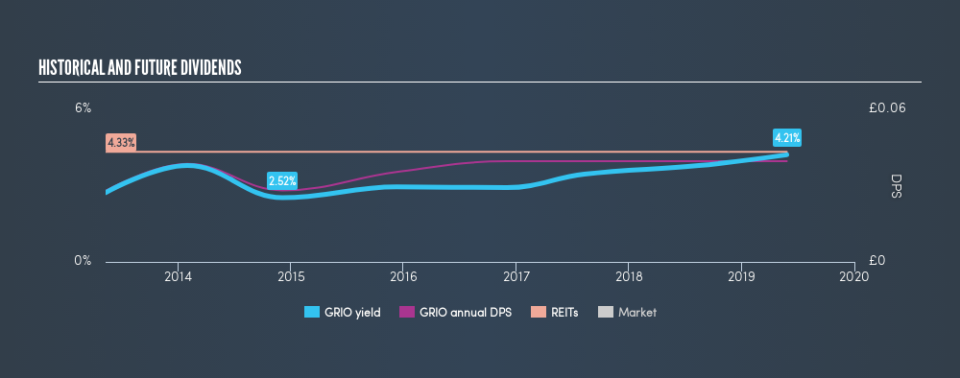Read This Before Buying Ground Rents Income Fund PLC (LON:GRIO) For Its Dividend

Is Ground Rents Income Fund PLC (LON:GRIO) a good dividend stock? How would you know? Dividend paying companies with growing earnings can be highly rewarding in the long term. Yet sometimes, investors buy a stock for its dividend and lose money because the share price falls by more than they earned in dividend payments.
In this case, Ground Rents Income Fund likely looks attractive to dividend investors, given its 4.2% dividend yield and six-year payment history. We'd agree the yield does look enticing. Some simple analysis can offer a lot of insights when buying a company for its dividend, and we'll go through this below.
Click the interactive chart for our full dividend analysis
Want to participate in a short research study? Help shape the future of investing tools and you could win a $250 gift card!
Payout ratios
Dividends are typically paid from company earnings. If a company pays more in dividends than it earned, then the dividend might become unsustainable - hardly an ideal situation. Comparing dividend payments to a company's net profit after tax is a simple way of reality-checking whether a dividend is sustainable. While Ground Rents Income Fund pays a dividend, it reported a loss over the last year. Paying out a majority of its earnings limits the amount that can be reinvested in the business. This may indicate a commitment to paying a dividend, or a dearth of investment opportunities.
Ground Rents Income Fund paid out 95% of its cash flow last year. This may be sustainable but it does not leave much of a buffer for unexpected circumstances.
Remember, you can always get a snapshot of Ground Rents Income Fund's latest financial position, by checking our visualisation of its financial health.
Dividend Volatility
One of the major risks of relying on dividend income, is the potential for a company to struggle financially and cut its dividend. Not only is your income cut, but the value of your investment declines as well - nasty. Ground Rents Income Fund has been paying a dividend for the past six years. Although it has been paying a dividend for several years now, the dividend has been cut at least once by more than 20%, and we're cautious about the consistency of its dividend across a full economic cycle. During the past six-year period, the first annual payment was UK£0.028 in 2013, compared to UK£0.04 last year. This works out to be a compound annual growth rate (CAGR) of approximately 5.9% a year over that time. Ground Rents Income Fund's dividend payments have fluctuated, so it hasn't grown 5.9% every year, but the CAGR is a useful rule of thumb for approximating the historical growth.
Dividends have grown at a reasonable rate, but with at least one substantial cut in the payments, we're not certain this dividend stock would be ideal for someone intending to live on the income.
Dividend Growth Potential
Given that the dividend has been cut in the past, we need to check if earnings are growing and if that might lead to stronger dividends in the future. In the last five years, Ground Rents Income Fund's earnings per share have shrunk at approximately 19% per annum. Declining earnings per share over a number of years is not a great sign for the dividend investor. Without some improvement, this does not bode well for the long term value of a company's dividend.
Conclusion
Dividend investors should always want to know if a) a company's dividends are affordable, b) if there is a track record of consistent payments, and c) if the dividend is capable of growing. Ground Rents Income Fund's is paying out more than half its income as dividends, but at least the dividend is covered both by reported earnings and cashflow. Second, earnings per share have been in decline, and its dividend has been cut at least once in the past. Overall, Ground Rents Income Fund falls short in several key areas here. Unless the investor has strong grounds for an alternative conclusion, we find it hard to get interested in a dividend stock with these characteristics.
See if management have their own wealth at stake, by checking insider shareholdings in Ground Rents Income Fund stock.
We have also put together a list of global stocks with a market capitalisation above $1bn and yielding more 3%.
We aim to bring you long-term focused research analysis driven by fundamental data. Note that our analysis may not factor in the latest price-sensitive company announcements or qualitative material.
If you spot an error that warrants correction, please contact the editor at editorial-team@simplywallst.com. This article by Simply Wall St is general in nature. It does not constitute a recommendation to buy or sell any stock, and does not take account of your objectives, or your financial situation. Simply Wall St has no position in the stocks mentioned. Thank you for reading.

 Yahoo Finance
Yahoo Finance 
